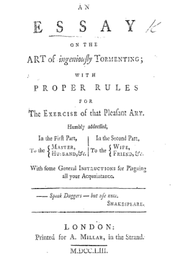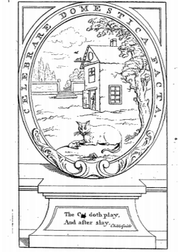
An Essay on the Art of Ingeniously Tormenting
Encyclopedia

Jane Collier
Jane Collier was an English novelist most famous for her book An Essay on the Art of Ingeniously Tormenting . She also collaborated with Sarah Fielding on her only other surviving work The Cry ....
's An Essay on the Art of Ingeniously Tormenting (1753), a conduct book
Conduct book
Conduct books are a genre of books that attempt to educate the reader on social norms. As a genre, they began in the mid-to-late Middle Ages, although antecedents such as The Maxims of Ptahhotep are among the earliest surviving works...
, was her first work. The Essay operates as a satirical advice book on how to nag and it was modeled after Jonathan Swift
Jonathan Swift
Jonathan Swift was an Irish satirist, essayist, political pamphleteer , poet and cleric who became Dean of St...
's satirical essays. The work is intended to "teach" a reader the various methods for "teasing and mortifying" one's acquaintances. It is divided into two sections that are organized for "advice" to specific groups, and it is followed by "General Rules" for all people to follow.
Although the work was written by Jane Collier, there are speculations as to who may have helped contribute to the content and style of the work, ranging from friends to fellow writers including Sarah Fielding
Sarah Fielding
Sarah Fielding was a British author and sister of the novelist Henry Fielding. She was the author of The Governess, or The Little Female Academy , which was the first novel in English written especially for children , and had earlier achieved success with her novel The Adventures of David Simple...
, Samuel Richardson
Samuel Richardson
Samuel Richardson was an 18th-century English writer and printer. He is best known for his three epistolary novels: Pamela: Or, Virtue Rewarded , Clarissa: Or the History of a Young Lady and The History of Sir Charles Grandison...
, and James Harris. There was only one edition printed during Collier's life, but there were many subsequent revisions and republications of the work after.
Background
In 1748, Collier was living with her brother, Arthur, in London. The conditions were not suitable, and she soon became the governess for Samuel RichardsonSamuel Richardson
Samuel Richardson was an 18th-century English writer and printer. He is best known for his three epistolary novels: Pamela: Or, Virtue Rewarded , Clarissa: Or the History of a Young Lady and The History of Sir Charles Grandison...
's daughter, Patty, by 1750. Richardson was impressed by her understanding of Latin and Greek along with her ability to perform her domestic duties. During this time, Collier was living with Sarah Fielding
Sarah Fielding
Sarah Fielding was a British author and sister of the novelist Henry Fielding. She was the author of The Governess, or The Little Female Academy , which was the first novel in English written especially for children , and had earlier achieved success with her novel The Adventures of David Simple...
, and Richardson would spend time discussing writing with them.
It was under Richardson's employment that she wrote An Essay on the Art of Ingeniously Tormenting and then published it in 1753 by Millar. It has been suggested that Richardson helped Collier write the work, but Richardson's lack of satirical skill has dispelled such ideas. Instead, it was probably James Harris and Fielding who helped craft the satire, and all three probably helped to edit the work. However, most of Collier's help came from Fielding, who was a close friend and shared many of her earlier works with Collier.
The first edition was printed by Richardson for Andrew Millar in 1753. A second edition of the Essay was published by Millar in 1757, two years after she died in 1755 but with revisions by her shortly after its first printing. It was subsequently editions and revisions were published in 1795, 1804, 1805, 1806, 1808, 1809, and 1811.
An Essay

Jonathan Swift
Jonathan Swift was an Irish satirist, essayist, political pamphleteer , poet and cleric who became Dean of St...
's satire, Instructions to Servants (1746), and even mentions Swift directly. However, Collier reverses the roles in Swift's satire and instead writes from a servant's perspective in the first book. All of her suggestions are to aid in the process of "teasing and mortifying".
She begins her work with an actual "Essay on the Art of Tormenting" serving as an introduction before dividing the book into two parts. In it, the narrator claims:
"One strong objection, I know, will be made against my whole design, by people of weak consciences; which is, that every rule I shall lay down will be exactly opposite to the doctrine of Christianity. Greatly, indeed, in a Christian country, should I fear the forces of such an objection, could I perceive, that any one vice was refrained from on that account only. Both theft and murder are forbidden by God himself: yet can anyone say, that our lives and properties would be in the least secure, were it not for the penal laws of our country?"
Part the First is divided into four sections: "Instructions to Masters and Mistresses, concerning their Servants", "To the Patronesses of an Humble Companion", "To Parents", and "To the Husband". To the master and mistresses, the narrator claims that "you are no true lover of the noble game of Tormenting, if a good dinner, or any other convenience or enjoyment, can give you half the pleasure, as the teasing and mortifying a good industrious servant, who has done her very best to please you."
Part the Second is divided into four sections: "To Lovers", "To the Wife", "To the Friend", and "To your Good Sort of People; being an appendage to the foregoing chapter". To wives, she tells them to "Be out of humour when your husband brings company home: be angry, if he goes abroad without you; and troublesome, if he takes you with him." When speaking to friends, she argues that "injuries go nearest to us, that we neither deserve nor expect."
Added to the work are "General Rules for plaguing all your acquaintance; with the description of a party of pleasure" along with a "Conclusion" and "A Fable". As a general rule, the narrator says, "By all means avoid an evenness of behaviour. Be, sometimes, extremely glad to see people; and, at other times, let your behaviour be hardly within the rules of good breeding."
Critical response
Most of her contemporaries had only good things to say about the work. Henry FieldingHenry Fielding
Henry Fielding was an English novelist and dramatist known for his rich earthy humour and satirical prowess, and as the author of the novel Tom Jones....
complimented Collier over the work by declaring she had "an Understanding more than Female, mixed with virtues almost more than human." This line was part of a greater poem written by Fielding and inscribed on a copy of his favorite book of Horace. This was one of Fielding's last actions before he left for Lisbon, the place that he would soon die.
Later, Betty Rizzo described the work as the "best-known generic satire written in the eighteenth century by a woman." The Battesins stated that Collier was "an author of wit and spirit". Some critics find it interesting that Collier would "yoke" Richardson with those that he "felt especial antipathy" with: Swift and Fielding. Katherine Craik claims the work as "a courageous social satire published at a time when satires were usually written by and for men."
See also
- The Cry: A New Dramatic FableThe Cry (book)Jane Collier's and Sarah Fielding's The Cry: A New Dramatic Fable was Fielding's sixth and Collier's second and final work. The work is an allegorical and satirical novel...
(1754), written by Collier and Sarah Fielding.

